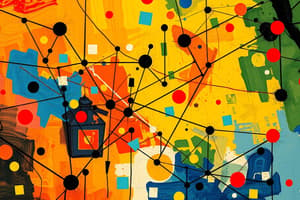Podcast
Questions and Answers
What is the primary goal of reinforcement learning?
What is the primary goal of reinforcement learning?
- To create a static algorithm for predictions
- To learn a policy that maximizes expected rewards (correct)
- To minimize the cost of actions over time
- To evolve states randomly according to fixed probabilities
In Markov Decision Processes, what influences the transition probabilities?
In Markov Decision Processes, what influences the transition probabilities?
- Fixed constants defined at the start
- The previous states in sequence
- The chosen action by the agent (correct)
- The current state only
What is a unique feature of reinforcement learning compared to supervised and unsupervised learning?
What is a unique feature of reinforcement learning compared to supervised and unsupervised learning?
- Random selection of training examples
- The use of labeled data for training
- Immediate feedback from the environment
- A feedback loop that drives learning (correct)
Which algorithm is used to solve Markov Decision Processes by calculating optimal state values?
Which algorithm is used to solve Markov Decision Processes by calculating optimal state values?
What does the Q-value represent in the context of Q-Learning?
What does the Q-value represent in the context of Q-Learning?
What is the first step in the Value Iteration Algorithm?
What is the first step in the Value Iteration Algorithm?
Which of the following best describes a Markov chain?
Which of the following best describes a Markov chain?
What type of learning algorithm is Q-Learning classified as?
What type of learning algorithm is Q-Learning classified as?
How many iterations does the Q-Learning algorithm typically take to converge?
How many iterations does the Q-Learning algorithm typically take to converge?
What does the error in Q-value update represent?
What does the error in Q-value update represent?
What approach does the ε-greedy policy use?
What approach does the ε-greedy policy use?
What is the primary purpose of using replay memory in Deep Q Learning?
What is the primary purpose of using replay memory in Deep Q Learning?
In policy-based methods, what is directly learned instead of a value function?
In policy-based methods, what is directly learned instead of a value function?
What optimization method is used within the Policy Gradient framework?
What optimization method is used within the Policy Gradient framework?
Which of the following statements about Temporal Difference learning is correct?
Which of the following statements about Temporal Difference learning is correct?
Why is calculating the true gradient of the objective function in Policy Gradient considered computationally expensive?
Why is calculating the true gradient of the objective function in Policy Gradient considered computationally expensive?
Flashcards
Reinforcement Learning (RL)
Reinforcement Learning (RL)
Learning a policy to maximize expected cumulative rewards in an interactive environment.
Markov Decision Process (MDP)
Markov Decision Process (MDP)
A mathematical framework for sequential decision-making, where the next state depends only on the current state and the action taken.
Bellman Optimality Equation
Bellman Optimality Equation
Recursively defines the optimal value of a state in terms of actions and their expected future reward.
Value Iteration Algorithm
Value Iteration Algorithm
Signup and view all the flashcards
Policy
Policy
Signup and view all the flashcards
Q-Learning
Q-Learning
Signup and view all the flashcards
Markov Chain
Markov Chain
Signup and view all the flashcards
Dynamic Programming
Dynamic Programming
Signup and view all the flashcards
Q-Value Iteration Convergence Speed
Q-Value Iteration Convergence Speed
Signup and view all the flashcards
Q-Learning and Experience-Based Learning
Q-Learning and Experience-Based Learning
Signup and view all the flashcards
Temporal Difference (TD) Learning
Temporal Difference (TD) Learning
Signup and view all the flashcards
Deep Q-Learning and Scalability
Deep Q-Learning and Scalability
Signup and view all the flashcards
Experience Replay in DQN
Experience Replay in DQN
Signup and view all the flashcards
Policy Gradient vs value-based learning
Policy Gradient vs value-based learning
Signup and view all the flashcards
Stochastic Policy
Stochastic Policy
Signup and view all the flashcards
Policy Gradient Theorem
Policy Gradient Theorem
Signup and view all the flashcards
Study Notes
Reinforcement Learning (RL)
- RL used for stock trading strategies by modeling trading as a Markov Decision Process (MDP)
- Intelligent agent interacts with environment, observes states, takes actions, and receives rewards
- Agent uses policy to decide actions
- Goal: learn policy maximizing expected cumulative rewards
- RL unique feedback loop; not found in supervised or unsupervised learning
Markov Decision Processes (MDPs) and Dynamic Programming
-
Markov chains: fixed number of states, random transitions
-
Transition probabilities depend only on current and next state, not past states (memoryless)
-
MDPs: agent can choose actions, transition probabilities depend on actions, state transitions yield rewards
-
Goal: find policy maximizing cumulative rewards
-
Bellman Optimality Equation: calculates optimal value (maximum expected reward)
-
Value of a state: immediate reward + discounted value of future states weighted by probabilities
-
Dynamic Programming: complex problems into smaller, simpler subproblems
Value Iteration Algorithm
- Calculates optimal value of all states using Bellman Optimality Equation
- Initializes state values to 0
- Iteratively updates state values until convergence
- Once optimal values known, optimal policy derived by maximizing rewards
- Example: Q-value iteration (works with state-action values Q(s,a) instead of state values V(s))
- Requires knowing transition probabilities (T) or rewards (R)
Q-Learning
- Model-free RL algorithm; estimates Q-values without knowing T or R
- Learns from experience, observing transitions (s → s′ with reward r)
- Updates Q-value estimates for (s, a) based on error (difference from target and current Q-value)
- ε-greedy policy: balances exploration (random actions) and exploitation (highest Q-value action)
- Temporal Difference (TD) learning similar but with state values instead of state-action values
- Q-Value iteration converges faster (less than 20 iterations) than Q-Learning (8,000 iterations)
Deep Q-Learning
- Large, complex environments
- Scalable neural network approximates Q-values via a Deep Neural Network (DNN)
- Experiences stored in replay memory
- Reduces correlations and stabilizes learning by randomly sampling experiences
- Faster training and more stable learning
Policy Gradient
- Policy-based method: learns optimal policy directly, not the value function
- Parameterizes policy function (e.g., neural network)
- Policy outputs probability distribution over actions for a given state
- Optimizes policy to maximize cumulative reward by defining and maximizing objective function to generate the best probabilities to be used as actions over time
- Policy gradient is an optimisation problem, gradient ascent is used; find the values of parameters that maximise objective function
- Can't calculate true gradient due to computational cost of all possible trajectories
- Policy Gradient Theorem reformulates objective function for gradients calculation
Studying That Suits You
Use AI to generate personalized quizzes and flashcards to suit your learning preferences.




